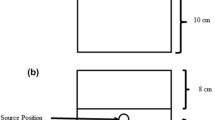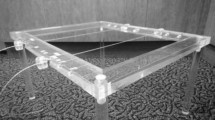Abstract
In vivo dosimetry of the patients treated by I-131 is important from patient dosimetry and radiation protection points of view. Knowledge of delivered dose to the target volume and adjacent normal tissues can improve the effectiveness of radioiodine treatment. Herein, design, fabrication, and assessment processes of an iodine radionuclide dosimeter (IRD) are explained. Two CsI(Tl) scintillator crystals coupled to photodiodes were used in IRD fabrication with specifications derived from Monte Carlo (MC) simulation. Linearity, sensitivity, and long-term performance of the system were tested. Delivered dose due to a known administered activity of I-131 was calculated by MC simulation which was validated based on the Medical Internal Radiation Dose (MIRD) Committee formalism, and the calibration factor was provided. Using the current mode signal acquisition method, the system showed a linear response up to 8.2 GBq radioiodine activity to prohibit the pile-up error without a need for correction factor. On the other hand, IRD was sensitive down to the rarely detectable activity of 7.4 MBq. A prototype version of the IRD system has been developed to guide the hospital staff for the safe release of iodine – administered patients and to provide an insight for physicians about the delivered dose to the thyroid and nearby organs.

IRD attached to MIHAN.





Similar content being viewed by others
References
Lassmann M, Reiners C, Luster M (2010) Dosimetry and thyroid cancer: the individual dosage of radioiodine. Endocr Relat Cancer 17:R161–R172
Giostra A, Richetta E, Pasquino M, Miranti A, Cutaia C, Brusasco G, Pellerito RE, Stasi M (2016) Red marrow and blood dosimetry in 131 I treatment of metastatic thyroid carcinoma: pre-treatment versus in-therapy results. Phys Med Biol 61:4316–4326
Hanscheid H, Canzi C, Eschner W, Flux G, Luster M, Strigari L, Lassmann M (2013) EANM Dosimetry committee series on standard operational procedures for pre-therapeutic dosimetry II. Dosimetry prior to radioiodine therapy of benign thyroid diseases. European journal of nuclear medicine and molecular imaging 40:1126–1134. https://doi.org/10.1007/s00259-013-2387-x
van Gils K, Brinks P, Lavalaye J, Verberne HJ, Habraken JBA (2017) A method to measure the absorbed dose of the thyroid during I-131 therapy, using a collar detector system and a SPECT acquisition. Med Phys 44:5450–5456. https://doi.org/10.1002/mp.12472
Sisson JC, Freitas J, McDougall IR, Dauer LT, Hurley JR, Brierley JD, Edinboro CH, Rosenthal D, Thomas MJ, Wexler JA, Asamoah E, Avram AM, Milas M, Greenlee C (2011) Radiation safety in the treatment of patients with thyroid diseases by radioiodine 131I: practice recommendations of the American Thyroid Association. Thyroid : official journal of the American Thyroid Association 21:335–346. https://doi.org/10.1089/thy.2010.0403
Venencia CD, Germanier AG, Bustos SR, Giovannini AA, Wyse EP (2002) Hospital discharge of patients with thyroid carcinoma treated with 131I. Journal of nuclear medicine : official publication, Society of Nuclear Medicine 43:61–65
Lee JH, Park SG (2010) Estimation of the release time from isolation for patients with differentiated thyroid Cancer treated with high-dose I-131. Nucl Med Mol Imaging 44:241–245. https://doi.org/10.1007/s13139-010-0041-0
Zuckier LS, Boardman B, Zhao QH (1998) Remotely pollable Geiger-Muller detector for continuous monitoring of iodine-131 therapy patients. Journal of nuclear medicine : official publication, Society of Nuclear Medicine 39:1558–1562
Brinks P, Van Gils K, Kranenborg E, Lavalaye J, Dickerscheid DBM, Habraken JBA (2017) Measuring the actual I-131 thyroid uptake curve with a collar detector system: a feasibility study. Eur J Nucl Med Mol Imaging 44:935–940. https://doi.org/10.1007/s00259-016-3595-y
Furstner M, Hentschel M, Spanjol PM, Prenosil GA, Weidner S, Krause T, Klaeser B (2017) Technical note: determination of individual thyroid clearance effective half-life with a common handheld electronic dosimeter. Med Phys 44:1558–1562. https://doi.org/10.1002/mp.12161
Knoll GF (2010) Radiation detection and measurement. 4th Ed. edn. John Wiley & Sons
Tavernier S (2010) Experimental Techniques in Nuclear and Particle Physics. 1st Ed. edn. Springer-Verlag Berlin Heidelberg
Pelowitz DB (2008) MCNPX USER’S MANUAL. Los Alamos National Laboratory, U.S.A
Ahmadi M, Ramezani M, Hariri-Tabrizi S, Azma Z (2019) Manufacturing and evaluation of a multi-purpose Iranian head and neck (MIHAN) anthropomorphic phantom. Phys med:(under review)
Amato E, Lizio D, Baldari S (2009) Absorbed fractions for photons in ellipsoidal volumes. Phys Med Biol 54:N479–N487. https://doi.org/10.1088/0031-9155/54/20/n02
Cember H, Johnson TE (2008) Introduction to health physics. 4th edn. McGraw-Hill Education
Mayles P, Nahum A, Rosenwald J (2007) Handbook of radiotherapy physics: theory and practice. Taylor & Francis Group, CRC Press, Boca Raton
Author information
Authors and Affiliations
Corresponding author
Ethics declarations
Conflict of interest
The authors declare that they have no conflict of interest.
Additional information
Publisher’s note
Springer Nature remains neutral with regard to jurisdictional claims in published maps and institutional affiliations.
Rights and permissions
About this article
Cite this article
Hariri Tabrizi, S., Ramezani, M., Feghhi, S.A.H. et al. In vitro evaluation of an iodine radionuclide dosimeter (IRD) for continuous patient monitoring. Med Biol Eng Comput 58, 763–769 (2020). https://doi.org/10.1007/s11517-020-02129-5
Received:
Accepted:
Published:
Issue Date:
DOI: https://doi.org/10.1007/s11517-020-02129-5




